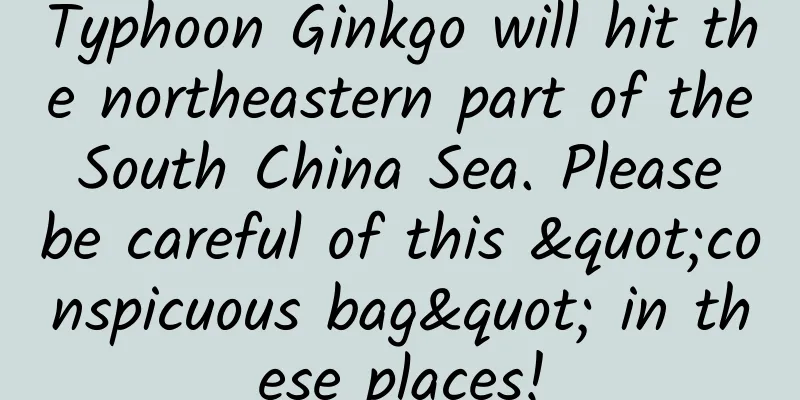Typhoon Ginkgo will hit the northeastern part of the South China Sea. Please be careful of this "conspicuous bag" in these places!

|
Since its formation on November 4, Typhoon Ginkgo has been moving northwestward, and its intensity has gradually increased. It is expected that Ginkgo will pass by or land on the northwest coast of Luzon Island in the Philippines (strong typhoon level or super typhoon level) on the night of the 7th or the early morning of the 8th, and then move into the northeastern waters of the South China Sea, bringing obvious strong winds to the southern waters of my country. Compared with the bustle on the sea, the land is relatively calm, with a smaller precipitation range, but it should be noted that in the next three days, the atmospheric diffusion conditions in North China, Huanghuai, Fenwei Plain and other places will deteriorate, and visibility will decrease, so you need to take good protection when going out. 01 Tracking the trajectory of Typhoon Ginkgo Meteorological monitoring shows that the center of Typhoon Ginkgo is currently located near the northeastern coast of Luzon Island, Philippines (super typhoon level, above level 17, 62 meters per second). It is expected that Ginkgo will move westward at a speed of about 15 kilometers per hour, and its intensity will weaken. It will pass or land on the northwest coast of Luzon Island, Philippines on the night of the 7th or the early morning of the 8th (strong typhoon level or super typhoon level, level 14-16, 45-55 meters per second), and move into the northeastern sea of the South China Sea on the morning of the 8th. After entering the South China Sea, due to the relatively good sea temperature conditions, Ginkgo will increase in intensity again and approach the waters near the Xisha Islands. The Central Meteorological Observatory continued to issue a typhoon blue warning at 10:00 today. Image source: China National Meteorological Administration 02 These places have done a good job in typhoon prevention It is expected that in the next 24 hours, under the combined influence of cold air and Typhoon Ginkgo, there will be strong winds of 6-8 and gusts of 9-10 in most parts of the East China Sea, the Taiwan Strait, the sea east of Taiwan, most parts of the South China Sea, the Bashi Strait, the coastal areas of Zhejiang, the coastal areas of Fujian, the coastal areas of Taiwan Island, the eastern coastal areas of Guangdong, the eastern coastal areas of Hainan Island, and the waters near the Xisha and Zhongsha Islands. Among them, the wind force in the Bashi Strait, the Taiwan Strait, and the northeastern waters of the South China Sea may reach 9-10 and gusts of 11-12. There will be strong winds of 11-13 and gusts of 14-15 in some waters in the southern Bashi Strait and the northeastern South China Sea. The wind force in the nearby seas or areas where the center of Ginkgo passes may reach 14-17, with gusts above 17. There will be heavy rain (25-40 mm) in the northeastern part of Taiwan Island. It is recommended that the above-mentioned areas make preparations for typhoon prevention. Image source: China National Meteorological Administration 03 Before the typhoon arrives, please check these preventive measures! Before a typhoon arrives, you should watch and learn about typhoon warning information in a timely manner, and prepare flashlights, candles, power banks, food, drinking water, and common medicines in advance for emergencies. Close doors and windows, and move items on windowsills indoors. Avoid going out, and outdoor entertainment venues should be closed. If it is a dangerous or old house, you should immediately evacuate to prevent the house from collapsing and causing casualties. Typhoons are often accompanied by thunderstorms. At this time, cut off the outdoor power supply in the dangerous area and turn off the plugs of electrical appliances as much as possible. People outside should not get close to trees, wires, manhole covers, loose and old walls and other buildings, and return to indoors as soon as possible. There is water on the main roads, so pay attention to trees and obstacles, slow down, and people on the hillside should be alert to landslides and mudslides caused by typhoons and rainstorms. If there is danger, evacuate as soon as possible. After the strong wind passes, the wind and rain may stop. At this time, do not rush to work outdoors. Make sure that the typhoon has passed before going out. Comprehensive sources: Central Meteorological Observatory, Xinhua News Agency, etc. Note: The cover image is a copyrighted image. Reprinting it may cause copyright disputes. |
>>: Why is “10 degrees in autumn” colder than “10 degrees in spring”?
Recommend
Alien biology? Bacterial RNA encodes new genes, breaking the central dogma
Produced by: Science Popularization China Author:...
WeChat’s private domain traffic business
In recent years, the term private domain traffic ...
In the era of mobile Internet, how can we find accurate users and obtain first-hand traffic at the lowest cost?
How can we find the precise users of our products...
Air purifiers are just transitional products: Even if the wind is strong, pigs may not fly
The stock market has been booming recently, with ...
Changan Oushang X7 PLUS interprets technological equality, 100,000-class SUV enjoys 300,000-class smart cockpit
The automotive industry is in a period of great c...
A 23-year-old woman suffered kidney poisoning after applying a whitening facial mask. How to determine whether there is mercury in cosmetics?
Audit expert: Zhang Yuhong Chief Physician of the...
Fun story: How to build a time machine?
Since the publication of the British writer Herbe...
Mobile technology for the masses: signing, packaging, and distributing Android apps
The addresses of the other four articles on mobil...
Wearing a mask = sun protection? Don’t be naive! Dermatologists give 6 suggestions!
How high is the temperature in Guangzhou recently...
Jixi watch mini program agent price inquiry, how much is the Jixi watch mini program agent price?
How much does it cost to be a Jixi agent for a wa...
Why can’t you do screen-sweeping marketing?
Many marketers have encountered a classic scenari...
Beware! These fruits on the roadside are poisonous, don't eat them! Be especially careful if you have children at home
Winter is here, and it is the season for bright r...
Samsung launches 31.5-inch 4K UHD monitor to enter the computer field
[September 9th news] At this year's IFA Berlin...
Do you feel anxious if you don't play mahjong for a day? Test your addiction level and stop when it's time
Whether it is young cubs Or middle-aged and elder...
In 2021, will you choose to use an iPhone or an Android phone?
The battle between iPhone and Android phones is a...






![300 fans can earn 1500 yuan a day. How to write articles that will make money as soon as they are published [paid articles]](/upload/images/67cc0fad908a5.webp)


